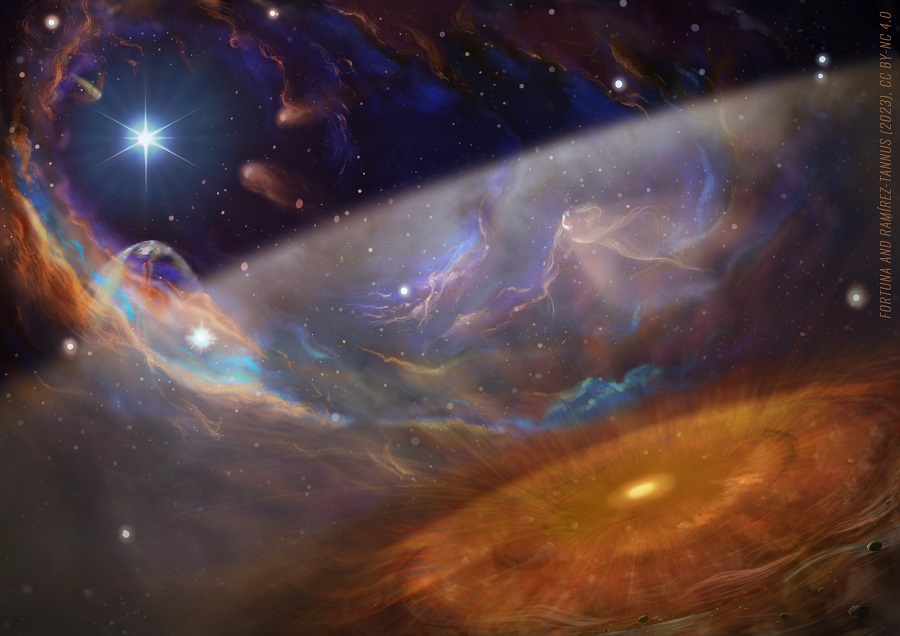Earth-like planets can even form under harsh conditions
Rocky planets like our Earth, including planets with water, could form even in the most extreme star-forming regions known, drenched in harsh ultraviolet radiation from massive stars. Astronomers discovered this with observations of such an area with the James Webb Space Telescope (JWST). The observations are the first of their kind - previously this was not possible. The results have been published in Astrophysical Journal Letters. Astronomers from Radboud University, the University of Amsterdam and the University of Groningen, including Inga Kamp of the Kapteyn Astronomical Institute, participated in the research led by the Max Planck Institute for Astronomy in Heidelberg (Germany).

Astronomers, using the MIRI instrument at the JWST, have discovered water and carbonaceous molecules in a disk of gas and dust surrounding a young, Sun-like star, located in one of the most extreme environments in our galaxy. The team of astronomers led by María C. Ramírez-Tannus from the Max Planck Institute used Webb to examine the inner part of the disk, where planets similar to our Earth are expected to form: rocky, with a thin atmosphere.
The disk, which astronomers call XUE-1, is exposed to intense ultraviolet radiation from nearby hot, massive stars. But even in this harsh environment, they found both water and simple organic molecules. First author Ramírez-Tannus: "This result is unexpected and exciting. It shows that there are favorable conditions for the formation of Earth-like planets and the ingredients for life, even in the harshest environments in our Galaxy."
Massive stars
The new observations are the first of their kind. Previous detailed observations of planet-forming disks were limited to nearby star-forming regions that did not contain massive stars. Star-forming regions with massive stars are completely different: numerous stars are born there at approximately the same time, including rare but very massive stars. During the 'golden age' of star formation in the universe, about 10 billion years ago, most star formation took place in such clusters. In total, more than half of all the stars in our universe - including our own sun - were born in these types of regions, along with their planets. Yet nothing was known about the effect of such a harsh environment on the inner regions of disks, where terrestrial planets are formed.
Massive stars are by definition very bright and emit large amounts of high-energy UV radiation. Their presence significantly disturbs the environment. It was thought that this disruption would mean that the formation of Earth-like planets would be rare. But a definitive answer could not be obtained because in the current universe star-forming regions with massive stars are rare and even the nearest ones are far away. Until recently, there was no way to observe small disks around sun-like planets in detail. The few planet-forming disks that are close enough to be observed in detail are all in quiet environments, without the intense UV radiation from massive stars.
Inner discs
Ramírez-Tannus and the XUE (eXtreme UV environments) collaboration observed the emission nebula NGC 6357, at 5,500 light-years from Earth one of the closest massive star-forming regions. NGC 6357 contains more than ten bright, high-mass stars, meaning some of the planet-forming disks in the region have been exposed to intense UV radiation for most of their existence. The region contains a variety of disks, some exposed to more and some to less radiation. "If intense radiation hinders planet formation conditions in the inner regions of protoplanetary disks, then NGC 6357 is where we should see the effect," says Arjan Bik of Stockholm University, co-PI of the XUE collaboration and second author of the article.
To their surprise, Ramírez-Tannus and her colleagues discovered that, when it comes to the presence (and properties) of key molecules, at least one of the inner disks in NGC 6357 is not fundamentally different from its counterparts in star-forming regions with low-mass stars.
Molecules
"We found an abundance of water, carbon monoxide, carbon dioxide, hydrogen cyanide and acetylene in the inner regions of XUE-1," says co-author Rens Waters (Radboud University). "This provides valuable clues about the likely composition of the original atmospheres of the resulting terrestrial planets." The researchers also found silicate dust, building blocks of rocky planets, in similar quantities as in star-forming regions with low-mass stars.
The inner regions of protoplanetary disks close to massive stars appear to be just as capable of forming Earth-like, rocky planets as their low-mass counterparts. They even provide an abundance of water, a necessary ingredient for life as we know it. Whether this actually translates into a significantly large number of Earth-like planets being born in such environments, the researchers cannot yet tell by looking at a single disk. “We will conduct further research within our JWST programme on another 14 disks in different parts of NGC 6357,” concludes co-author Lars Cuijpers (master student at Radboud University).
More news
-
15 September 2025
Successful visit to the UG by Rector of Institut Teknologi Bandung
